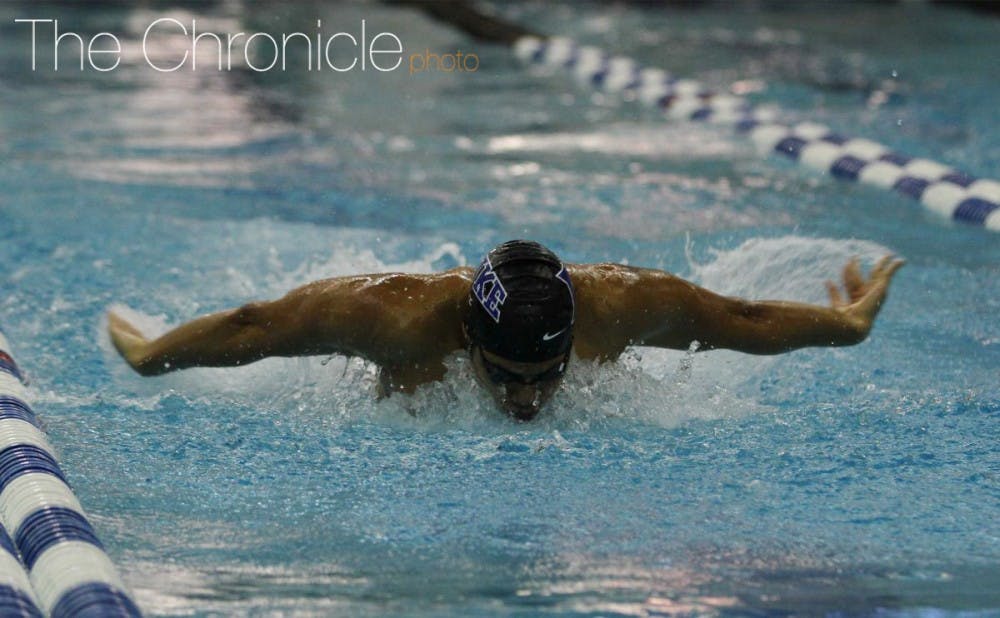As the Blue Devils get set for their season-opening meet this weekend in Blacksburg, Va., you might notice something odd when you see Duke swimmers walking around campus—the large, dark bruises fans grew accustomed to seeing on Olympians like Michael Phelps this summer in Rio.
The exact “cupping” therapy Phelps and others used hasn’t quite made it to Durham, but Corey James, an assistant athletic trainer who works with the Blue Devil swimming and diving team, uses a similar treatment to help Duke’s athletes recover from grueling workouts.
Called myofascial decompression, the treatment uses suction cups and a pump to lift skin, muscle and tissue to stimulate blood flow and reduce soreness.
“You’re going to have these big, hickey bruises, so you have to let the physicians know,” James said with a laugh. “You have to let the teachers know too, so they don’t think I’m doing anything crazy.”
Although MFD seems exactly like cupping to the casual observer, James said there is a key difference. He first became exposed to MFD in 2011 as a graduate student at San Jose State, then took a course in June 2015 to become certified.
“I used to call it cupping, but once you actually learn the differences between MFD and cupping, you realize that they actually are two different principles,” James said. “Cupping has been around for 5,000 years, and the Chinese used it to neutralize the inner chi, or energy lines. MFD looks more at fascia, a tissue that lays over the top of muscle.”
When fascia becomes bound with knots, James offers MFD to lift the fascia up and promote drainage of waste products in the muscle. Because it stimulates blood flow to the affected areas, MFD is best for treating overused muscles, he explained.
Given the popularity of cupping this summer and the past few years, it’s not surprising that several Blue Devils have been lining up to have James try the treatment on them.
“I have a nagging soreness in my knee right now, and I’m using it to take pressure off my quads and hamstrings,” said junior Nick Bigot, a freestyle swimmer who was on Duke’s 400- and 800-meter freestyle relay teams at last year’s ACC championship. “It definitely seems to help loosen my body up, and I’ll do it maybe once a week. It certainly seems to be helping me in terms of practices.”
Another key difference between cupping and MFD is that the cups used in MFD are not heated. James said that ideally the tissue fills the cup after the pump starts lifting the skin, but when a muscle is stressed, the skin looks dented, signaling that more treatment is necessary to reduce soreness.
He said one of the most notable examples of MFD helping a swimmer was when a competitor James chose not to name was dealing with a back injury. The ailment was so serious that the athlete was having trouble taking deep breaths, let alone considering getting into the water.
“After the treatment, he was able to take deep breaths, move, and it really helped him kick the corner. I was pretty amazed at how fast it worked,” James said. “The treatment was on a Wednesday and he was able to swim at 85-95 percent at a meet on Saturday.”
With MFD helping Blue Devils who use it, Duke will look to take advantage of improved ranges of motion when it takes on Virginia Tech, William and Mary and West Virginia this weekend.
James has shared the technique with other trainers at the University, noting that the baseball team’s trainer has tried it a few times to supplement other recovery techniques, but added that MFD is not a panacea—it needs to be combined with other standard therapies to be effective.
The treatment might also be most effective for swimmers.
“Swimmers tend to notice the difference more because they’re unweighted. They’re in the water and essentially floating, so they can really feel it,” James said. “They need great ranges of motion in their arms and hips.”
Although the bruises might look odd at first, the Blue Devils have opted for the unusual treatment as they look to send several competitors back to the NCAA championship.
“There’s a general curiosity about it, and it’s one of the most popular modes of recovery,” Bigot said. “I’m not embarrassed by it at all. A lot of the people I’m talking to are athletes and know about it, but if my parents, for example, asked about it, I have enough knowledge to explain what goes into it.”
Get The Chronicle straight to your inbox
Signup for our weekly newsletter. Cancel at any time.

